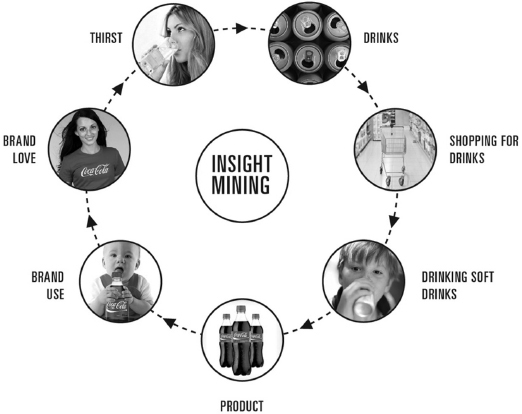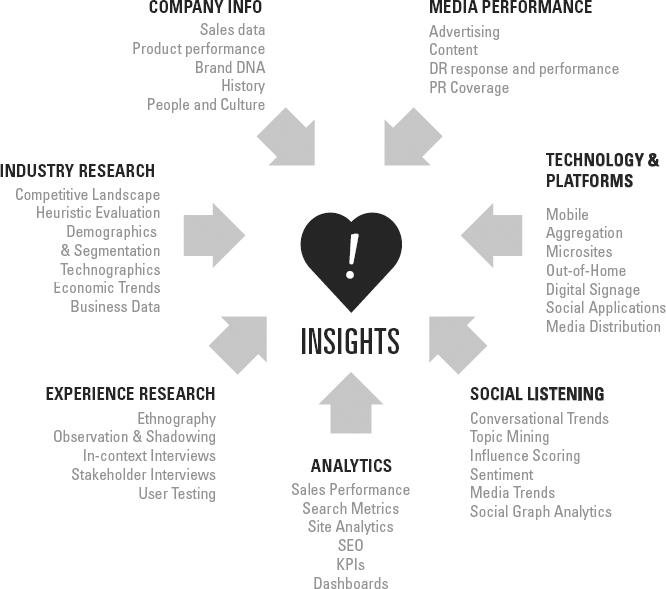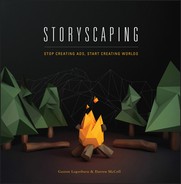
CHAPTER 07
INSIGHT TO DESIRE
Understanding the Values and Aspirations of the Consumer
Have you ever observed the intriguing phenomenon where dogs and their owners have similar looks, personalities, or traits? Do you think that is something people rationally strive for or just a natural occurrence resulting from the deep-seated love for their dogs? Our devotion to our dogs is often well beyond rational, much the same way they love us unconditionally and beyond reason. The joyous pants and tail wags we are greeted with upon our return home every day—not just on the good days; the compassionate look pulsing from those big brown eyes when we confide in them with our deepest thoughts. How about the smile they give when we bring out their favorite toy? All these interactions make us feel great and the mutuality is palpable. It’s all related to the emotional connection we have with them. Even if the dog cannot actually smile at us, we feel a smile because we feel connected beyond the rational or logical, and we appreciate the slightest recognition of that (even if it’s only our imagination).
Have you ever wondered why it’s so difficult to express what it means to be in love? Love is believed to be one of the most emotional feelings we have. The feeling of love comes from the deepest emotional triggers in our brains (sorry, it’s not our hearts). Scientists have studied the brain for many years to understand the differences between emotional and rational thinking. It is regularly suggested that there are different parts inside our complex and brilliant brains, where emotion and logic live. It has also been suggested that things such as language and expression, which are learned skills, activate a different part of the brain than emotions and feelings. Then it stands to reason that logic is easier to explain than an emotion such as love. This bit of knowledge counters the clichéd gender difference that men find it more difficult to express feelings; instead, it’s more to do with mere physiology. Working from this premise of language as logic and love as emotion, it makes perfect sense why it’s much harder to express what love is.
These are just a couple of examples to illustrate that not every decision is simple or logical. Logic will not drive emotions, and emotions have as much to do with behavior as logic does. Emotions without the logic to guide the behavior simply stimulates feelings. This is the reason we need to explore both rational needs and emotional desires when we are looking to connect brands with consumers across the Experience Space.
In this chapter, we are specifically looking at consumer insights into emotional influences and desires. We will dig into what we should look for and provide some ideas on how to think about consumer insights. We value and appreciate that communities of marketers, psychologists, sociologists, researchers, and others have all spent years studying the consumer and offer great insight, methods, and understandings. We will touch on some of these concepts and teachings as they apply to Storyscaping and use them to add context in an honest, yet by design, superficial way. But instead of exploring the depths of “the collective unconscious,” the “principles of socialization,” or similar concepts, our aim is to build understanding and application as it relates to Storyscaping.
Change or Cash In. No one would argue with the statement that we live in a world of change. Some argue that the rate of change with modern technology is faster than ever. The reality is that everything is faster, bigger, better, and smarter than it was before—even our phones are smart now. That’s called evolution, and every generation sees some form of it. That’s why no matter what generation you are from—Baby Boomer, Gen Y, Gen X, Gen C, Gen Z, Gen Alphabet—you will at some stage utter, “When I was young. . . .” Simply put, change is inevitable. General Eric Shinseki, former U.S. Army Chief of Staff, stated, “If you don’t like change, you’re going to like irrelevance even less.”1 Although his comment was in reference to adapting within the armed forces, it also works well with respect to how our social connectedness and networked lives have created a heightened need to keep up with change. The expectation is on us as much as it is on the social manifestation of a world enabled by ubiquitous technology. The ways in which we interact, connect, share our lives, and tell our stories have all changed with the influence of our always-on technology that we just can’t live without. At the same time, the power of using stories to engage and connect us emotionally hasn’t changed. Why not? Because even though our world is changing, the underlying psychology of how we respond emotionally hasn’t changed. Maslow’s hierarchy of needs is as relevant today as it ever was. What about Jung’s theories about archetypes and the collective unconscious? Yes, also still relevant. Even a peek at a more recent perspective, like that of Hugh Mackay (in his book What Makes Us Tick? The Ten Desires That Drive Us), proves that the old theories are still in good working order.2 A healthy understanding of these theories and concepts related to our psychological desires is helpful. It’s also important to remember that people are people. Although we are each different, we are complicated, we are imperfect, we live in a world of change, we also have very common and connected emotional desires. These are the very desires that we can leverage for brand stories and brand connections—magical ones that enable shared values and provide great consumer insights.
Skin in the Game. To find, discover, rediscover, or unearth great insights, we need more than context and an appreciation for emotional desires; we need to step into the skin of our consumers. Wherever possible, we strongly suggest enlisting deep and broad research behind insights appropriate for the challenge. At SapientNitro, we are blessed with a powerful team of researchers and insight specialists who provide rich understanding and input into our thinking. We strongly believe in the power of research and highly recommend each and every application of the Storyscaping model be built around the knowledge drawn from real consumer understanding—no matter how that is established.
Our goal here is to connect our brands and consumers on an emotional level using shared values, stories, and experiences in an effort to inspire consumer participation. To claim success, we really need to understand the consumer; the influences on their emotions; how they feel about things; and how our brands, stories, and experiences can remain relevant in the hyperconnected, always-on world. This requires real insight—not just observation but an inside, personal scoop.
Insight is a broad word and is often overused, even abused, among our marketing brethren. Our industry includes people who are “insight specialists” and are part of “insight teams.” To us, what these folks represent is a desire to understand consumers. The Merriam-Webster Dictionary defines insight as “the ability to understand people and situations in a very clear way,” going on to describe it as “the act or result of apprehending the inner nature of things or of seeing intuitively.” It means that in order to have great consumer insight, we really need to explore the inner nature of why people do the things they do and how they feel about those things. At the same time, intuition and Spidey sense play a role in defining great insight too. It’s a simple fact that although research is scientific, mathematical, and typically involves technology, people are people—imperfect and sometimes irrational. Therefore intuition, experience, and diverse understanding all play role in exploring consumer insight.
When it comes to brands, we often consider consumer insight as being “a revelation about human behavior or an emotion that can be leveraged to connect a brand” or “a new usable perspective on the relationship between a brand and its existing or intended consumers.” Insights are sometimes discovered as widely recognized truths or habits. Alternatively, insights may come from grasping or comprehending the obscurity of things. In other words, they might not be obvious or intuitive at first, but insights should always exude truth in their discovery.
In Storyscaping, one of the four pillars for an Organizing Idea is consumer insight. When working on this pillar, we sort and find one paramount insight that will connect the brand and consumers on an emotional level, in a relevant way, and in a manner that inspires creativity to fuel the brand story. We look for the strongest and most motivating insight we can leverage. Brilliant brand stories are created from brilliant insights. This particular insight into consumers’ emotions and feelings is likely to identify a challenge that the brand can solve for the consumer. It is a reflection of the consumer’s everyday experience, attitudes, views, or values. It’s a critical component for creating a meaningful brand connection and for creating a Storyscape that connects with consumers. Spare no effort to understand consumers and earn this insight. Collaborate with others and explore options and opportunities. Also apply your Spidey sense because intuition is a powerful tool, especially when it comes to insight.
As we continue along the journey of Storyscaping, we look for and identify many other insights from different perspectives or lenses. In Chapter 6, we briefly looked at cultural insights and category insights. Additional exploration of consumer behaviors and their interactions with products, distribution, transactions, media, content, and each of these in social media must happen.
Fancy Meeting You Here. The first step to great insight is having a very clear view of consumers. The tighter and more specific your consumer definition is the more focused your insight can be. Conversely, if you have a broad consumer group, your insights will most likely be very broad. For example, let’s say you are promoting a tourism destination and your potential participants are located all over the globe. For you, consumer insight is likely to be very high level and include a limited and common emotional understanding across people from many markets, many cultures, and many environments. Yet, if you are looking at teens in their last year of high school, you can be very specific with your focus. Both instances are perfectly acceptable because they are based on your consumer brand connection challenge. The key is to have it defined. When you do, you will be better equipped to explore insights within the frame defined by the desired group.
Truly understanding the emotional toils or cultural influences of a consumer is priceless. No amount of effort, exploration, or discovery is too much when it comes to finding fresh and authentic insight. It pays to explore all the dimensions of consumers and their emotional variances. When we look at a typical consumer as illustrated, we explore insights at every stage. In doing so, we ensure that our exploration delves into dimensions of cultural influence and competitive influence. We are looking for new and usable perspectives on consumer emotion and desires. Let’s unpack that a little further.
Ask and You Shall Receive. We start with the human need or stimulus. In this illustration we explore “thirst”—an unconscious feeling that triggers a need. We can explore the reasons we get thirsty by asking appropriate questions: Is it a time of day occurrence? Is it environmental? Is it health? Is it instinctive, like breathing? When thirsty, how do we feel and why do we feel that way? So many questions to ask and answer, and we are only at step 1!
The category of drinks is huge, so on with more questions: What do we already know about drinks? What don’t we know? What have we had in the past? What influences us? What are the trends? Why do we like one drink over another? What is the competitive landscape? Why are there so many choices? How do we navigate choice? How do we feel about the category and why? This step includes a lot of discovery around the category.

Shopping, the buying behavior, and how we can and do transact is a rich bed for insight discovery. Looking into things like convenience, times, volumes, portfolios shopped, influence of recency in messaging, spontaneity of purchases, how we navigate, which purchase behaviors exist and why, all unlock insight into how we buy. Even efforts of mining down to how we feel about value, price, rewards, and promotions can offer worthwhile insight.
Next, we look at how we might consume within the category. The underlying platforms here include how we interact with competitors and why we use certain products and sometimes in different ways. We also look deeply into how consumption of products in that category makes us feel. Do we get a special lift from the bubbles in soda? Do we hold our face close to the glass so the bubbles tickle our nose? Do we drink fast to belch? Is thirst satisfied quickly or slowly? Which feelings are produced from these interactions: joy, indulgence, satiation, naughtiness, or refreshment? And why is that the case? Do some brands give us feelings that are different from others and if so, why?
When it comes to your product, it is important to look at how it is used within its intended fashion. Here we could be looking for consumption insights like: Do we consume a lot of it—when and why? What factors influence the way we use the product? How do we feel? Why do we drink Coke? Do we feel different than when we drink comparable beverages? And again, why?
Unintentional brand use is yet another dimension to explore. You may find interesting insight when poking through the ways in which people use products differently than their intended use. Here we can connect the brand and consumers on a special level because the diverse use of products can be insightful. For instance, you can look at the use of Coke for cooking or for curing nausea.3 Then ask some more questions: How do we feel knowing this? Does everyone know? Are we inspired by versatility? Does the packaging hold special significance? Is it used for something else? Why? Follow those questions up with some more whys.
What about the brand itself—outside of the product? How does it make us feel? Why do we feel that way? Are we fans or consumers? What does the brand say about me? Is there status in the brand? Why? What about awareness? Is there cultural influence? What trends or styles exist around the brand? What is the social conversation and why? How does the brand resonate? Why?
Revert to Age Five. Five-year-olds get it. Have you ever noticed how kids at the age of five always ask “why?” They are at a stage in life when they seek knowledge and understanding because they don’t have preconceived views from experience or a lifetime of learning. This fresh inquisitive nature is not jaded by what they already know like it is with us self-proclaimed experts. This unfiltered, and never satiated, perspective is truly a gift when looking for insights. So even when you think you know what the insight is, ask yourself and ask your teams, “Why is that the case? Why do consumers feel that way?” Become a five year old for a few minutes and see how that helps in apprehending the inner nature of things.
These are just some examples of the dimensions and questions we can explore. Not all will yield powerful consumer insight for emotional connection or storytelling but some will. The fun of it is that you just never know where the most valuable insight is going to pop up. With time and experience applied, the exploration becomes more focused. That said, you’ve certainly noted an important trend to apply during insight exploration: asking the question “Why?” Remember how Chapter 6 highlighted the value of asking why? during the process of Brand Purpose exploration? This why unlocks the emotions behind consumer feelings and actions. It is the most powerful word in the determination of insights. In our busy lives where we are constantly making decisions, we often forget to stop and explore the reasons and the triggers—the whys.
Understanding the sort of things we look for when mining for insights is a great start. Now here’s some assistance with where and how to look for them. This is when research proves critical. In our opinion, research is most valuable when used to inform great thinking, rather than when trying to justify or assess great thinking.
The nature of the brand, the consumer, the product, and the environment all have an influence on the exact sources of insight. Here is a fairly simplified illustration as an example to show you what that looks like:

Similarly, the methods you use are defined by the need. You can use qualitative methods to uncover what people say they do and use ethnographic fieldwork to uncover what they actually do. This includes the engagement of remote ethnography, mobile research, experience modeling, in-context interviews, and video and photo capture. Secondary research can lead to understanding cultural trends, demographics, industry changes, technology adoption, and media and trend analyses. Finally, quantitative research and analysis has taken leaps forward in both data and technology. We have resources that provide quantitative surveys and panels, which establish representativeness and significance of the brand and category. We can observe and adjust our business based on the behavior dynamics we learn about from technology-based tracking systems and modeling. We will discuss behavioral and experience research more in the next chapter because it’s certainly an area of exploration for behavioral insight. Although quantitative data don’t always yield insight into emotions, they can uncover areas that should be explored. For example, if a pattern of behavior is discovered when a product is used in a particular way and you ask “Why?”, you can then unearth insight into brand influence, social status, or other emotional spaces.
Although research is a powerful tool, you should also maintain a healthy cynicism because not all the answers are not found in research. Don’t take the numbers, statistics, and responses at face value. To find real insight, research these findings, explore, and discuss them even further. We also feel research is best used to inform thinking rather than to judge thinking. Testing messaging can be useful, but realize that testing anything after the direction is set will not create real and new insight, because it is based on an existing frame of reference. In other words, use your intuition and a healthy of dose cynicism with regard to research so you can ensure it’s used in a meaningful way without overdramatizing what it says. Think about what you’re using it for and how you’re doing it. Is a planned and moderated focus group the right way to gain insight into how people feel, or will that just give you what respondents want to say? Hugh Mackay, a renowned psychologist and social researcher, offers his view: “Focus groups are nothing more than a bunch of strangers, meeting in a strange place, saying strange things.” Instead, what Hugh and his teams have very effectively done for years is conduct discussion groups in context of the normal lives of people, with friends, with neighbors or with work colleagues meeting in their natural habitats—the home of one of them, or a workplace, a club, or wherever they would naturally meet and feel most comfortable.4 Here the research is more ethnographic in nature. It is observational and it studies the conversation arch, the participants, behaviors, and sentiment. It’s a more immersive approach with less risk of strangeness diverting the discussion or findings. It’s also highly nondirective.
The fact remains: Insight comes from understanding, and research is one great means to that end. Remember that because emotions are by no means rational (like a research method is), there are other means to connect with your consumers—through the use of intuition and insight.
We’ve talked our talk about consumer insights, so now let’s explore how we’ve walked that talk.
INSIGHT: “You don’t truly experience something unless you immerse yourself in it.”
This was an insight we uncovered about global travelers in partnership with the Tourism Queensland teams. This became part of the strategy behind our “The Best Job in the World” project created together with Tourism Queensland in Australia.5 This project achieved world acclaim for its ability to inspire billions of people across the globe to watch and follow the job applications for roughly 35,000 hopeful applicants, each of whom created hundreds of thousands of news articles and content pieces promoting Queensland’s Islands of the Great Barrier Reef. The idea of “The Best Job in the World” was born out of the strong strategic insight that “you don’t truly experience something unless you immerse yourself in it.” Consumers all over the world seek greater value in the quality of experiences they have. “Fly and flop” types of vacations and holidays are diminishing. People want real experiences that they can share with friends upon return (and electronically while they are there). They want more than just seeing. They want to do, feel, and touch. They want to explore. They want to immerse themselves. As such, our insight territory tapped into the heart of the modern traveler—the traveler who sees potential on the Internet but knows they need to be immersed in that experience in person. What better way is there to be immersed in paradise than to live there—with a job, “The Best Job in the World?”
INSIGHT(S): “Competition in people, performance, and power” (The two-way player) and “Connection with culture and expression” (The avid player).
There were two consumer profiles for our work with the X Games. Each consumer audience engaged for different emotional reasons. We resolved to address both of them through experience and a single Organizing Idea. In this project, the two-way player was someone who loves the competition side of sports and watches it on TV. By contrast, the avid player loves action sports so much that he or she is part of the culture. Avid players live for the expressive nature and creativity of action sports, and they are out there perfecting “ollies” day in day out. In this project, we worked hard to build the Story System to connect with both players and to connect both players together through shared experiences and shared content. You can read more on the ESPN X Games story in Chapter 9.

Now that we’ve explored the context of emotional connection and insights, where we look for them, and how to look at them, let’s think about how insight serves as a pillar for the Organizing Idea. Using this new and vast understanding of your consumer, look for consumer insight into desire. This emotional desire can inspire a story for your Brand Purpose and become the conduit for connection with consumers. This insight provides a consumer frame of reference for the Organizing Idea. Remember: We are looking for “a revelation about human behavior or an emotion that can be leveraged to connect a brand” or “a new usable perspective on the relationship between a brand and its existing or intended consumers.” Insight enables you to understand people and situations in a very clear way. Make your work both inspiring and focused—and of course, be insightful.
